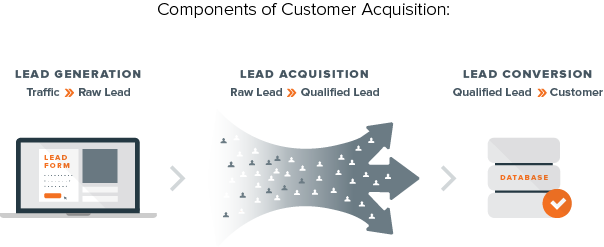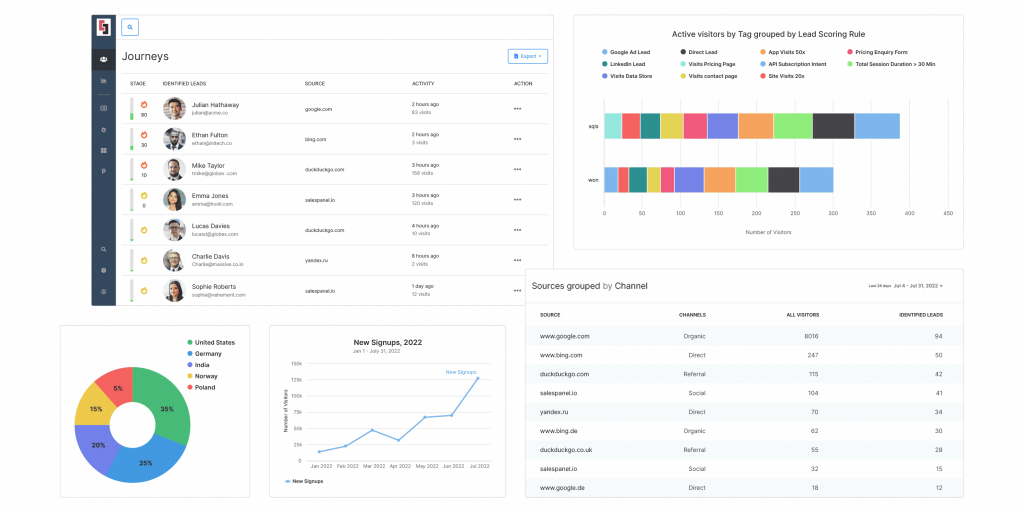What Is Lead Acquisition? Best Strategies For 2024!
Updated on May 18, 2024
Every business needs a steady stream of leads to support consistent growth. However, filling up your pipeline can be tricky. 65% of businesses cite lead generation (Source: Hubspot) as one of their top challenges. This is where lead acquisition strategies come into play.
Lead acquisition or lead generation is the process of attracting potential customers to your business and engaging them with the ultimate objective of converting them into customers.
Now, you might be wondering, does lead “acquisition” and lead “generation” mean the same thing? If not, how is lead acquisition different, and how can the best lead acquisition strategies be implemented?
We will discuss it in this article. Let’s begin!
What is Lead Acquisition?
Before we get to defining lead acquisition, you must first know what a lead is.
A lead is a person or a business with an interest in buying the products or services you sell. Coming to lead acquisition, it is the process of obtaining a new lead and qualifying and nurturing them as you work towards converting them.
Here is an illustration of the components of customer acquisition:

Image Source: ActiveProspect
So, how is lead acquisition different from lead generation? Let’s learn about it below.
How is Lead Acquisition Different from Lead Generation?
If we consider simple linguistics, lead generation ispretty similar to lead acquisition. However, since the latter focuses on acquiring, one could say that the acquisition happens when the lead enters the funnel by filling out a form or scheduling a meeting. But, this is not what everyone agrees with.
While many use lead generation and lead acquisition interchangeably, some parties have defined lead acquisition as the next step after lead generation. This is when you nurture, segment, and qualify your leads and send them to the next stages of the funnel. So, everything between lead generation and conversion would come under ‘lead acquisition’ territory.
There is another definition that we see floating around. Some websites claim that while ‘lead generation is the generation of leads by you, ‘lead acquisition is the process of acquiring qualified leads from a third-party vendor. This definition, however, feels dubious and might have been pushed by vendors who sell leads.
Since there is no fixed definition laid out by a foundation with authority, we thought it would be best to present all the definitions circulating in the space to you. You may pick as you prefer!
Now, let’s discuss why lead acquisition is important.
Why is Lead Acquisition Important?
Lead acquisition is important as it is the first stage of the customer journey and is necessary to move on to the next phase, which is turning leads into customers.
Here is what lead acquisition enables you to do:
- Brand Awareness and Market Expansion: Obtaining leads from various demographic groups and sources can help businesses reach a wider audience and build their brand. Sophisticated lead acquisition strategies can facilitate a brand’s entry into unexplored markets by connecting it with new audience groups and geographic areas.
- Customer Insights and Product Improvement: Lead acquisition provides valuable data and insights into customer preferences, behaviors, and pain points. Analyzing this information can help businesses personalize their products or services to meet customer needs, enhance marketing strategies, and improve customer experience.
- Business Growth and Revenue Generation: Lead acquisition fuels the sales pipeline by continuously bringing in potential customers who can be nurtured and converted into paying customers. Without a steady stream of new leads, a business may struggle to grow its revenue, ultimately impacting its long-term viability and success.
Thus, having a robust lead acquisition process can have many benefits. However, as stated above, lead acquisition can be quite a challenge. Let’s understand how.
Challenges Associated with Lead Acquisition
Here are some reasons why lead acquisition can be a demanding endeavor:
- Market Saturation and Competition: Many industries are highly competitive, with numerous companies vying for the same pool of potential customers. This makes it harder to stand out and capture the attention of leads, especially if competitors have well-established brands or larger marketing budgets.
- Changing Consumer Behaviors: Consumers today have more access to information and choices than ever before. They are more discerning about marketing messages, often conducting extensive research before engaging with a brand. This requires businesses to create more value-driven content to attract and retain leads.
- Evolving Markets and Technologies: The rapid evolution of digital marketing channels and technologies means businesses must continually adapt their strategies. Keeping up with the latest trends, platforms, and tools requires significant time, effort, and investment. Failure to effectively leverage these advancements can result in missed opportunities and inefficient lead acquisition efforts.
Considering these challenges, wonder how you can best acquire leads? Given below is a list of lead acquisition strategies to improve your ROI.
Best Lead Acquisition Strategies to Improve Your ROI
Now that we understand lead acquisition more or less, let’s discuss some lead acquisition strategies that can help you generate quality leads, improve your funnel, and acquire more customers.
Quality over quantity
Lead generation is not hard. What is difficult is the acquisition of leads who will actually buy from you.
Acquire leads from marketing channels that bring good results. Or, if you are sourcing outbound leads, make sure you source high-quality leads.
Check for intent
Let’s say you are a lead scoring software company.
Lead A searches for “lead scoring,” and Lead B searches for “best lead scoring software.” Which of these two leads do you think has more intent? While Lead A might just be looking for information on lead scoring, Lead B is looking at tools.
Lead acquisition with clear intent is far more likely to have better conversion rates for your business.
Monitor entire customer journeys and use attribution
The lead acquisition process runs through the entire customer journey. Thus, building an efficient funnel requires you to monitor customer journeys.
Customer journey tracking helps you understand how leads engage with your sales and marketing content before they purchase. It lets you identify channels that bring high-quality leads, attribute marketing engagement and channels with conversions, and optimize the experience for more efficient acquisition.
A tool like Salespanel can help you do this.
Qualify your leads
Lead generation may focus on the raw number of leads; however, “lead acquisition” measures the acquisition of qualified leads. To that end, this system needs to have a lead qualification framework. Not every lead you generate will be qualified, and spending resources on them would be wasteful.
Thus, it is essential to use a lead qualification framework, such as lead scoring or segmentation.
Lead qualification is heavily dependent on data which is why you need to collect and analyze a lead’s profile and behavioral data. If your customers are B2B, you can prioritize leads who match your target customer profile and are decision-makers. We have already discussed behavioral attributes that imply intent in the previous section.
Use segmentation
Not all of your leads have the same customer profiles and are looking for the same solutions. As such, it is important to segment your leads and sort your buyer profiles. In this way, you can use the segments to qualify, prioritize, and show targeted content.
Leads can be segmented based on:
- Buyer profile and firmographic characteristics
- Acquisition channels (through attribution)
- Key behavioral traits
- And, many other attributes.
Do proactive marketing during the acquisition process
With all of these data points and marketing power, you no longer need to be reactive during the acquisition process. Instead, you can proactively engage your leads with highly targeted and personalized content and fast-track leads who are more likely to buy.
Segment and qualify leads in real-time and show content that will resonate with them.
Automate and Track Your Lead Acquisition Process
In the above-mentioned pointers, we have discussed lead acquisition and several strategies that can help you in the process. But, the question is, how do you execute them? Every great strategy needs a great tool (or tools). We will start with a customer journey tracking implementation, as this sets the foundation for your lead acquisition framework.
Salespanel can help you track the customer journey of every visitor on your website right from their first visit to their last. It will track the source of your visitor and attribute it to your marketing campaign. The software uses UTM parameters (and the ValueTrack template for Google ads) to help you with more accurate attribution.
Once journey tracking is set up, the behavioral data is available for you to implement several functions. You can use behavioral data to:
- Send targeted email campaigns based on intent
- Gradually score leads
- Segment high-intent profiles
- Show personalized content based on interests.
Salespanel can help you implement all of these. The tool also provides you with firmographic data, but if you need more vivid data, a data platform like Clearbit or ZoomInfo can help.

Closing Thoughts
While the definition of lead acquisition is murky, it doesn’t change what you need to do to improve your lead generation and customer acquisition process. Once a lead is acquired, you have to do the needful to nurture and qualify, and send qualified leads to your sales reps. To acquire better customers, double down on high-performing campaigns and strengthen your overall lead acquisition strategy today!
Sell more, understand your customers’ journey for free!
Sales and Marketing teams spend millions of dollars to bring visitors to your website. But do you track your customer’s journey? Do you know who buys and why?
Around 8% of your website traffic will sign up on your lead forms. What happens to the other 92% of your traffic? Can you identify your visiting accounts? Can you engage and retarget your qualified visitors even if they are not identified?


